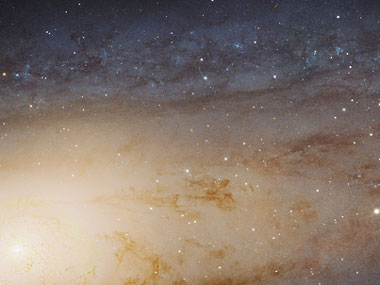NASA’s Hubble Space Telescope has captured images of the Andromeda galaxy and the Pillars of Creation in the sharpest resolution ever taken of the two cosmic bodies. [caption id=“attachment_2034779” align=“alignleft” width=“380”] Part of the image of Andromeda captured by Hubble. Coutresy: NASA website[/caption] The bird’s-eye view of a part of the Andromeda galaxy, which is the nearest spiral galaxy to the Milky Way, is the largest Hubble image ever assembled, according to
NASA’s official website
. “It’s like photographing a beach and resolving individual grains of sand,” according to NASA. The website also says that even though the galaxy is more than two million light-years away, the Hubble telescope is powerful enough to capture even indidivual stars in a stretch of the galaxy 61,000 light-years long. “Never before have astronomers been able to see individual stars inside an external spiral galaxy over such a large contiguous area,” said NASA. The Pillars of Creation, on the other hand, were first photographed by Hubble in 1995, according to this
report
in the IBTimes. The Pillars of Creation is the name given to the nebulous cloud and dust located 7,000 light-years away from the earth. NASA shot the images of the nebula in greater detail to celebrate the 20th anniversary of those images. The report also said that “the images depict changes in the nebula over the past two decades, including erosion of some parts of the pillars by radiation and strong winds from nearby stars.” The image of the nebula was taken in near-infrared light, which can penetrate a large part of the gas and dust, revealing the stars both behind the nebula as well as hidden inside the pillars, according to NASA.
Part of the image of Andromeda captured by Hubble. Coutresy: NASA website[/caption] The bird’s-eye view of a part of the Andromeda galaxy, which is the nearest spiral galaxy to the Milky Way, is the largest Hubble image ever assembled, according to
NASA’s official website
. “It’s like photographing a beach and resolving individual grains of sand,” according to NASA. The website also says that even though the galaxy is more than two million light-years away, the Hubble telescope is powerful enough to capture even indidivual stars in a stretch of the galaxy 61,000 light-years long. “Never before have astronomers been able to see individual stars inside an external spiral galaxy over such a large contiguous area,” said NASA. The Pillars of Creation, on the other hand, were first photographed by Hubble in 1995, according to this
report
in the IBTimes. The Pillars of Creation is the name given to the nebulous cloud and dust located 7,000 light-years away from the earth. NASA shot the images of the nebula in greater detail to celebrate the 20th anniversary of those images. The report also said that “the images depict changes in the nebula over the past two decades, including erosion of some parts of the pillars by radiation and strong winds from nearby stars.” The image of the nebula was taken in near-infrared light, which can penetrate a large part of the gas and dust, revealing the stars both behind the nebula as well as hidden inside the pillars, according to NASA.
NASA's Hubble telescope takes images of Andromeda, Pillars of Creation in highest resolution
FP Staff
• January 7, 2015, 17:19:11 IST
NASA’s Hubble Space Telescope has captured images of the Andromeda galaxy and the Pillars of Creation in the sharpest resolution.
Advertisement
)
End of Article